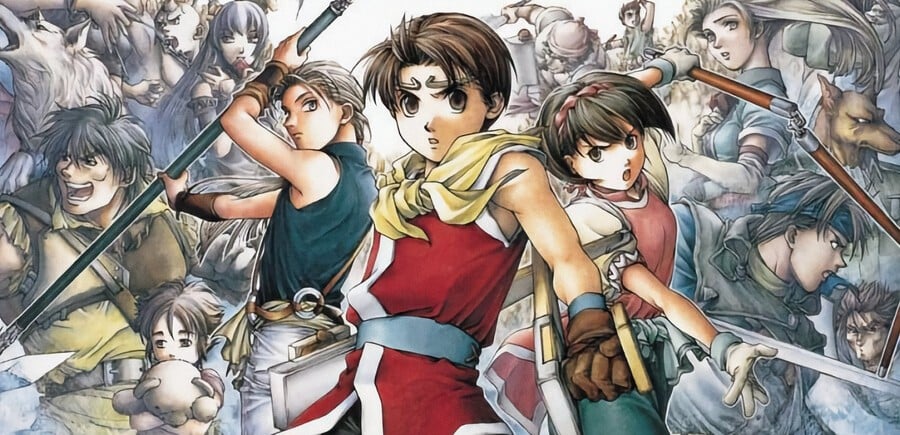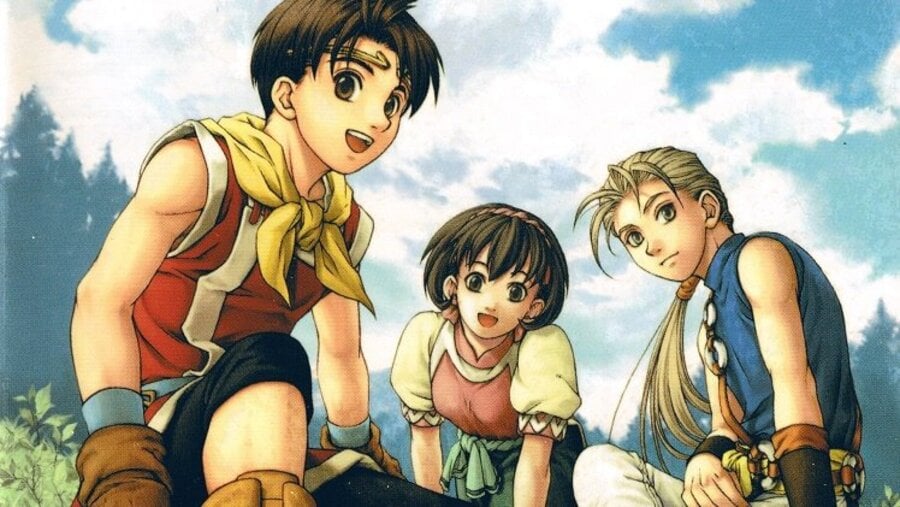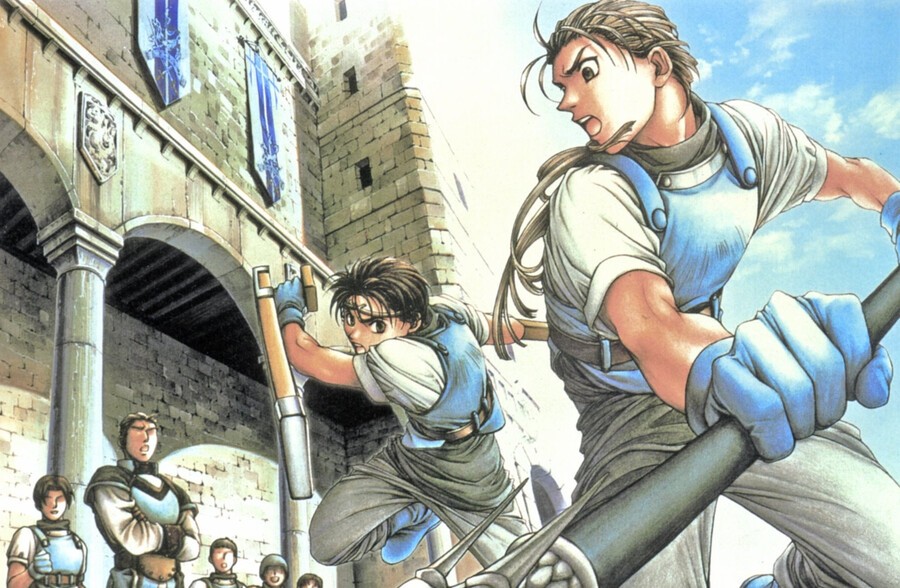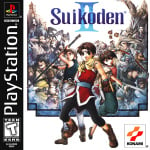
This piece follows on from our feature on the making of Suikoden, which you can read here.
Spoiler Warning: We've tried as best as possible to avoid Suikoden spoilers (there is one), but we definitely spoil Final Fantasy VII, because if you don't already know Aerith dies, you've not been paying attention.
Roughly three years after the first Suikoden, in December 1998, Suikoden II would launch in Japan. Despite the gap between them, and the distinct storylines, it's worth considering both as part of the same grand saga (and it's important not to mix the aforementioned Suikoden Zero and Suikoden II up, despite both following on from the first).
Veterans of the first could even import their save data into the second, for a neat bonus quest with the original hero! However, while the first enjoyed relatively little competition, the second was born into a post-Final Fantasy VII world, where numerous other developers tried to capitalise on the surging popularity of JRPGs. Also, Final Fantasy VIII was just around the corner.
With its 2D graphics and glut of rivals, Suikoden II may have been bigger, more refined, and all-around better than its predecessor, but it didn't have quite the same impact. Which is a shame, because not only was it more than twice as long (around 50 hours versus under 20), but it was mechanically more complex; the simple army battles of the first were replaced with proper turn-based strategy maps, plus there were cool minigames.
Some magazines were unkind – which is ironic, because fervent demand 25 years later has created price tags of £200 and up. Does Final Fantasy VIII command that now? Electronic Gaming Monthly scored it 7, shoehorning it into a 1/6th of a page – which is weird, because on that same page, they give Xena: Warrior Princess 1/3rd of a page, despite scoring it 4. GamePro scored it 13/20, which is 65%. Official PlayStation Magazine in the US gave it a more reasonable 80%. Edge seemingly didn't even bother reviewing it. More respectful was Computer & Video Games, in issue 223, which gave it a full five stars, proclaiming it to be better than Final Fantasy VIII! As for GameFan, by this point, founder and editor Dave Halverson and several crew had departed for Gamer's Republic, and under new management, it wasn't the same. Even so, GameFan gave it a decent 83%, while Gamer's Republic rated it B+.

One of the strongest aspects of any modern RPG, other than the battles and complex spreadsheet management of stats, is, of course, the story. But this leaves us with a conundrum here. If you're reading this, you've either played the games and there won't be spoilers, or you've not played it and are curious to know more. In which case, we need to tread lightly, because both games – but especially Suikoden II – have so many dramatic events their impact will be lessened if we ruin it. For this author, both games are all-time favourites, both for the story and the mechanics. Reading the histories and epilogues of each of the recruitable 108 characters gives the world greater melancholy and gravitas than anything Square-Enix ever put out. The series tackled difficult issues with more heartfelt realism than any game of the time.
Both titles deal with very adult topics, including patricide, terrorism / freedom fighters, chemical weapons, genocide, the execution of war criminals, the killing of civilians, racial prejudice, betrayal, and other things. So much has been written about the death of Aerith in Final Fantasy VII, but when you compare that one scene to the entire story arc of Suikoden I and Suikoden II, it seems faintly ridiculous. Sure, some bad alien DNA magic man kills a flower girl. It's totally sad. We're literally crying as we type these words. But in Suikoden I, within the first few hours, you have to murder your own father in order to free your homeland from a tyrannical leader. The setting is more grounded, and the dialogue more poignant. We've now spoiled one aspect of the first game, but simply in order to say that the rest of the first game, and the entirety of the second game, only escalates things. We're talking Game of Thrones levels of complexity and betrayal.
Given how grimdark the war story in the second game can become (real tears will flow if you allow the saddest ending), I asked the late Yoshitaka Murayama when I interviewed him back in 2013 if there was any resistance from management, and did he realise he was forging new grounds of literary excellence in games? "Since the story was left up to me, I never directly received any criticism," he revealed. "Since I myself decided to make the theme of it 'war', although there were aspects that I put in to make it more game-like, I created a story that wouldn't allow people simply to close their eyes to the realities that exist in war. With regards to the existence of acts such as 'war' and 'death' in the game, I did not intend to force my own personal views on players. If players felt anything regarding such issues, I'd like them to decide for themselves how they feel about them. If players see something of value in there, nothing could possibly make me happier."
We also brought up the character deaths in Suikoden II with its localiser, Jeremy Blaustein. "Right, the deaths of the characters!" he exclaims, as we describe a scene we found particularly moving. He loads up a YouTube video to remind himself. "I've just rewatched the death of [REDACTED]. That was incredible. Great music. Nice, smooth dialogue. Many translators were on this project, and they were divided up by character instead of just doing chunks of text. This was to maintain consistency of voice. And yet, when you consider Suikoden II graphically, it was quite cartoonish. Isn't that amazing? That did not prevent you from experiencing the emotion of that particular scene. Because you knew those hand-drawn images represented characters, they didn't need to look like your next-door neighbour to feel they were human. It's a suspension of disbelief, and games these days, it's as if the idea of suspension of disbelief, or the idea of actually engaging people to use their own imaginations – it's almost like it's become a bad word."
We've already covered The Water Margin and why the first game deviated from the source material, but the second game seems even more unrelated (apart from again having 108 stars of destiny). Even though the series has common tropes like dragons and elves and so on, if you've ever felt that the Suikoden flavour was unlike a lot of other JRPGs, it's probably because it's influenced by real-life Chinese history. So, I asked Murayama about his literary influences. What else did he enjoy reading?
"From an early age," he began, "I was a fan of old fables like The Water Margin (Suikoden) and Romance of the Three Kingdoms (Sangokushi), and I was strongly influenced by them to do a multi-character story. However, I decided that a pure Chinese-style worldview was not a good choice for a Japanese RPG with a major fantasy focus, and so it became a half-fantasy and half-Chinese style worldview. For Suikoden I, I designed some story episodes based to a degree on The Water Margin, but since Suikoden II was based on the story 'Kouu and Ryuuhou', it got rather far away from Suikoden."

While The Water Margin and Romance of the Three Kingdoms novels are well documented in English, this "Kouu and Ryuuhou" was a little more difficult to place. Googling the Japanese (項羽と劉邦) brings up manga, board games, old computer games, and a whole wave of semi-related material. So we asked The Japanese Game Preservation Society, who explained that Murayama likely meant this Japanese novel, which began serialisation in the 1970s, about the rivalry of Xiang Yu and Liu Bang, based on real events from the Chu-Han War. In 1984, it was condensed into three volumes. There doesn't seem to be any translations or even much information in English. For an intensely detailed analysis of the story in Suikoden II, in relation to the above, see this interview on Shmuplations. Basically, the hero in Suikoden II represents Liu Bang, while his childhood friend Jowy represents Xiang Yu.
Translating all this narrative into English was quite an ordeal! Far more difficult than the first game. Localiser Casey Loe shared some lengthy anecdotes of what it was like: "I believe everyone was working at their individual homes. We had no ability to add text boxes, and our English text had to fill the same size text boxes as in the Japanese version. The released version ended up using a non-fixed length English font that seemed to allow for more text than the Japanese font, and at some points in the game (like the endings), they did manage to increase the size of the text windows, but at the point at which I was working on the project, we didn't know that would happen, and our marching orders were to stick to the original Japanese character limits. Writing the same line in English usually takes at least twice as many characters, so if the original Japanese line filled up all four lines of the text box, then the English text would need to be cut to the bone to make it fit. That meant going over every line dozens of times, replacing every word with its shortest possible synonym, cutting every bit of flavour and information that wasn't absolutely essential, deleting any idiom that wasn't more space-efficient than what it represented, and so on, until lines I had once been proud of were reduced to elementary-school primer text. And then, since the final game did end up having a thinner font that often didn't fill up the text boxes, it often ended up looking look like we made those cuts for no reason at all."
What about the background to all of it, based on Chinese history? It's been documented Murayama created an encyclopaedia to keep track of the game's complicated lore. What did he recall of this?
"It was a digital Word document," explains Loe, "but I don't recall the page count. Probably a fairly standard world-building document by today's standards, but in that day and age, it was pretty shocking to see a video game with a depth of background comparable to a fantasy novel series. I believe it was all text, although there may have been a map included. I'm not tech-savvy enough to know if the files we were working on were source code or what, but I recall it as strings of English text in files full of gibberish, probably the instructions regarding the text and character portrait display. I believe we were eventually able to figure out which character was speaking by matching hexadecimal strings or something. Fortunately, Nick [Des Barres] and I were big Suikoden fans who had already played the game and were able to recognize much of the out-of-context content – which was why Jeremy Blaustein gave us a chance, instead of working with more experienced translators who wouldn't be willing to spend so much time navigating through a game as they worked."
Blaustein's recollection of the project is of wanting to make each character unique, but feeling constrained by the limitations of English. As he explains: "It's my recollection that the assets came to us in a rather, erm... disorganised way. Things wound up being kind of disorganised. When you have Suikoden II, with its 108 characters, right? A hundred and eight! You'd like each character to have a unique voice. What most people don't understand is [that] Japanese offers you the opportunity to have an extremely wide range of voices in written material. Because it's a manga culture, or the fact Japanese can be written in two or three different writing styles, there's so many different dialects. In Japanese, you can make a lot of things clear in the way that you write dialogue. The reader can read it and say, 'This is an 80-year-old person from the north-eastern region of Japan, who has a lower class education, and a bad sense of humour, and watches a lot of cop dramas.' You can get all that out just by how you write down the written word. Now, in English, you don't have that. But now you've got 108 characters to localise!"
Despite a few vocal fans who criticise the localisation, playing through Suikoden II still packs a phenomenal punch, a testament to how good the original material was, matched by the detailed pixel art and evocative soundtrack. We weren't able to speak with any of the artists or composers, so we've just leave you with this rousing opening:
Despite how emotional the narrative could be, there was still time for lighter moments in Suikoden II – one of the best was the new cooking minigame. Throughout the game, you could find recipes and condiments, and then participate in culinary tournaments against a rival, then be judged by your peers. In a previous interview a colleague of Murayama claims there were 240 varieties of food in the design documents. So I had to ask him directly about this wonderful distraction. As Murayama explained: "At the time, there was a popular manga that showed off the beauty of food in a competition format. I think we were strongly influenced by that in making this minigame. At first, it was a little simpler, but at some point, the designer increased the number of food graphics and we began to add a lot to match them. <laughs>" Sadly, Murayama didn't reveal which specific manga this was – and it turns out there were a lot!
After such an in-depth conversation, it seemed there couldn't be anything left to say, but I asked anyway – is there perhaps any anecdote no one has heard before? Murayama did not disappoint. "Hmmmm, that's a tough one," he laughed, adding, "The voice of the flying squirrel, Mukumuku, from Suikoden II, was done by me! <laughs>"
Despite the sad passing of Murayama, let's try to end on a positive note. If you've read this feature and the words resonate because Suikoden holds a special place in your heart, and perhaps you identify with someone specific within, take comfort in the fact Murayama knew of your joy.
As he once revealed: "Even now, I receive mail from inside Japan as well as from overseas, and I am extremely grateful to those fans out there that love Suikoden. The characters in Suikoden are not just large in number, but each one of them was born as an individual with their own unique characteristics and backgrounds. If people can find, among them, a character that they can empathise with, then I am very happy."
May your next adventure be truly epic, Murayama-sama.
John Szczepaniak is a journalist and internationally published author. If you enjoyed all this interview material, please check out his Untold History series of books. There are over a million words of developer interviews across the series.

